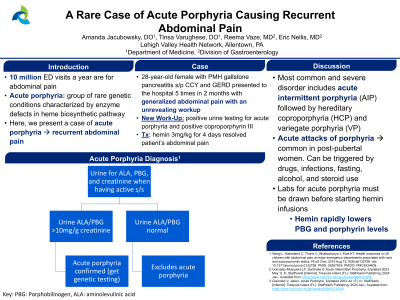Tuesday Poster Session
Category: Colon
P3688 - A Rare Case of Acute Porphyria Causing Recurrent Abdominal Pain
Tuesday, October 29, 2024
10:30 AM - 4:00 PM ET
Location: Exhibit Hall E

Has Audio

Amanda Jacubowsky, DO
Lehigh Valley Health Network
Allentown, PA
Presenting Author(s)
Amanda Jacubowsky, DO1, Tinsa Varughese, DO1, Reema Vaze, MD2, Eric Nellis, MD2
1Lehigh Valley Health Network, Allentown, PA; 2Eastern Pennsylvania Gastrointestinal and Liver Specialists, Allentown, PA
Introduction: Abdominal pain has a wide differential diagnosis and accounts for approximately ten million emergency department visits each year. Here, we present a rare case of recurrent abdominal pain in a patient diagnosed with acute porphyria.
Case Description/Methods: A 28-year-old female with a history of gallstone pancreatitis status post laparoscopic cholecystectomy and GERD presented to the hospital with two days of generalized, colicky abdominal pain. Associated symptoms included nausea, non-bloody non-bilious emesis, constipation, and visual hallucinations. Of note, she had presented to the hospital with similar concerns five times in the prior two months with no identifiable diagnosis. Initial lab testing on arrival revealed an unremarkable complete blood count panel, AST 43 U/L, ALT 131 U/L, ALP 266 U/L, total bilirubin 0.4 mg/dL, lipase 33 U/L, and negative urine pregnancy test. CT abdomen pelvis and right upper quadrant ultrasound images showed normal bile ducts with evidence of a prior cholecystectomy. She had a liver biopsy performed to evaluate chronically elevated liver function testing. Pathology showed mild lobular hepatitis without significant fibrosis and mild pigment deposition within Kupffer cells. With persistent abdominal pain and psychiatric changes, hematology was consulted with concern for acute porphyria. Urine and plasma porphyrins were collected, and the patient was started on hemin 3 mg/kg infusions for 4 days with resolution of her presenting symptoms.
Discussion: Acute porphyria includes a variety of rare genetic conditions characterized by enzyme defects in the heme biosynthetic pathway. The most common and severe disorder includes acute intermittent porphyria followed by hereditary coproporphyria and variegate porphyria. Acute attacks of porphyria are common in post-pubertal women and can be triggered by drugs, infections, fasting, alcohol, and steroid use. Diagnostic testing for porphyria includes the measurement of porphobilinogen (PBG), aminolevulinic acid (ALA), and total porphyrins from the same urine sample. These levels must be drawn before starting the treatment of hemin infusions because hemin rapidly lowers PBG and porphyrin levels. In our patient, her laboratory testing resulted in normal urine PBG and ALA with elevated 24-hour uroporphyrin at 147 ug/24 hr) and coproporphyrin III at 95 ug/24 hr. With improvement on hemin infusions, she was diagnosed with acute porphyria while awaiting confirmatory genetic testing for further characterization of her condition.
Disclosures:
Amanda Jacubowsky, DO1, Tinsa Varughese, DO1, Reema Vaze, MD2, Eric Nellis, MD2. P3688 - A Rare Case of Acute Porphyria Causing Recurrent Abdominal Pain, ACG 2024 Annual Scientific Meeting Abstracts. Philadelphia, PA: American College of Gastroenterology.
1Lehigh Valley Health Network, Allentown, PA; 2Eastern Pennsylvania Gastrointestinal and Liver Specialists, Allentown, PA
Introduction: Abdominal pain has a wide differential diagnosis and accounts for approximately ten million emergency department visits each year. Here, we present a rare case of recurrent abdominal pain in a patient diagnosed with acute porphyria.
Case Description/Methods: A 28-year-old female with a history of gallstone pancreatitis status post laparoscopic cholecystectomy and GERD presented to the hospital with two days of generalized, colicky abdominal pain. Associated symptoms included nausea, non-bloody non-bilious emesis, constipation, and visual hallucinations. Of note, she had presented to the hospital with similar concerns five times in the prior two months with no identifiable diagnosis. Initial lab testing on arrival revealed an unremarkable complete blood count panel, AST 43 U/L, ALT 131 U/L, ALP 266 U/L, total bilirubin 0.4 mg/dL, lipase 33 U/L, and negative urine pregnancy test. CT abdomen pelvis and right upper quadrant ultrasound images showed normal bile ducts with evidence of a prior cholecystectomy. She had a liver biopsy performed to evaluate chronically elevated liver function testing. Pathology showed mild lobular hepatitis without significant fibrosis and mild pigment deposition within Kupffer cells. With persistent abdominal pain and psychiatric changes, hematology was consulted with concern for acute porphyria. Urine and plasma porphyrins were collected, and the patient was started on hemin 3 mg/kg infusions for 4 days with resolution of her presenting symptoms.
Discussion: Acute porphyria includes a variety of rare genetic conditions characterized by enzyme defects in the heme biosynthetic pathway. The most common and severe disorder includes acute intermittent porphyria followed by hereditary coproporphyria and variegate porphyria. Acute attacks of porphyria are common in post-pubertal women and can be triggered by drugs, infections, fasting, alcohol, and steroid use. Diagnostic testing for porphyria includes the measurement of porphobilinogen (PBG), aminolevulinic acid (ALA), and total porphyrins from the same urine sample. These levels must be drawn before starting the treatment of hemin infusions because hemin rapidly lowers PBG and porphyrin levels. In our patient, her laboratory testing resulted in normal urine PBG and ALA with elevated 24-hour uroporphyrin at 147 ug/24 hr) and coproporphyrin III at 95 ug/24 hr. With improvement on hemin infusions, she was diagnosed with acute porphyria while awaiting confirmatory genetic testing for further characterization of her condition.
Disclosures:
Amanda Jacubowsky indicated no relevant financial relationships.
Tinsa Varughese indicated no relevant financial relationships.
Reema Vaze indicated no relevant financial relationships.
Eric Nellis indicated no relevant financial relationships.
Amanda Jacubowsky, DO1, Tinsa Varughese, DO1, Reema Vaze, MD2, Eric Nellis, MD2. P3688 - A Rare Case of Acute Porphyria Causing Recurrent Abdominal Pain, ACG 2024 Annual Scientific Meeting Abstracts. Philadelphia, PA: American College of Gastroenterology.
